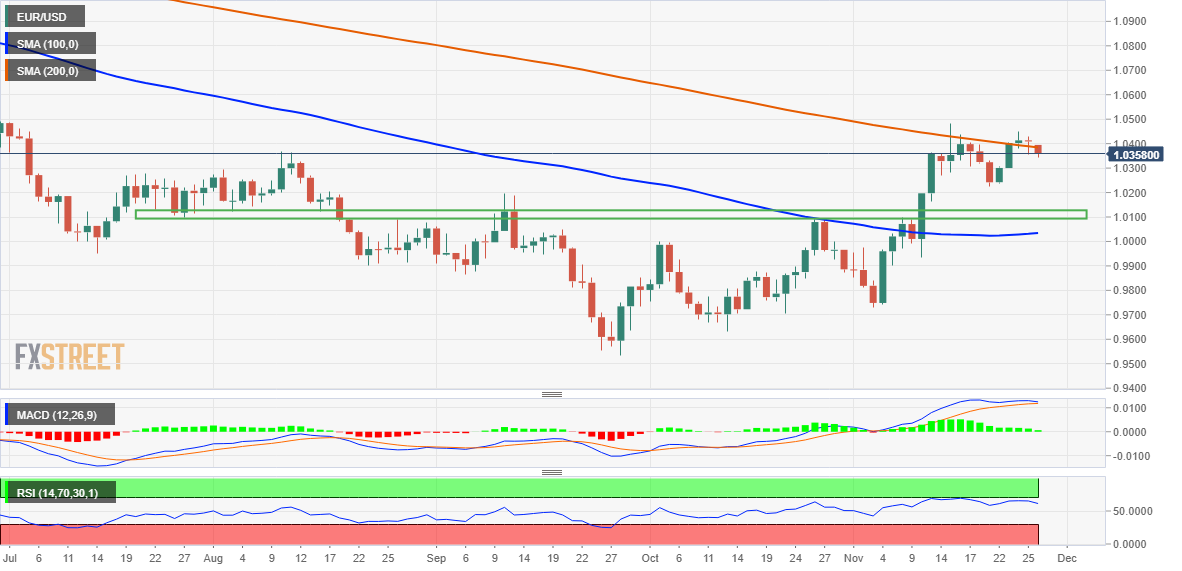- EUR/USD remains on the defensive for the second straight day amid a modest USD strength.
- China’s COVID-19 woes weigh on investors’ sentiment and benefit the safe-haven greenback.
- Bets for less aggressive Fed rate hikes could cap the buck and limit the downside for the pair.
The EUR/USD pair edges lower during the Asian session on Monday and moves away from its highest level since August 12 touched last week. The cautious market mood – amid worries about the worsening COVID-19 situation in China – offers some support to the safe-haven US Dollar and drags the major lower for the second straight day. China recorded a record-high number of daily infections on Saturday, forcing the government to impose strict anti-COVID measures in several cities. Furthermore, public discontent over the zero-COVID policy flared protests across China and raised concerns about a further slowdown in economic activity. This, in turn, keeps investors on edge, evident from a generally weaker tone around the equity markets and driving haven flows towards the greenback.
The flight to safety and growing acceptance of a less aggressive policy tightening by the Fed continue to exert downward pressure on the US Treasury bond yields. It is worth recalling that the minutes of the November FOMC meeting released last Wednesday showed that most policymakers agreed it would soon be appropriate to slow the pace of interest rate hikes. This, in turn, could hold back the USD bulls from placing aggressive bets. In contrast, the European Central Bank (ECB) is expected to deliver another supersized 75 bps rate increase in December. This might continue to underpin the shared currency and further contribute to limiting the downside for the EUR/USD pair, at least for the time being.
Moving ahead, there isn’t any major market-moving economic data due for release on Monday, either from the Eurozone or the US. Hence, traders will take cues from scheduled speeches by ECB President Christine Lagarde and influential FOMC members – St. Louis Fed President James Bullard and New York Fed President John Williams. This, along with the US bond yields and the broader risk sentiment, will drive the USD demand and provide some impetus to the EUR/USD pair. The focus, however, will remain on the flash Eurozone CPI print on Wednesday and the closely-watched US monthly jobs data – popularly known as NFP on Friday. The key macroeconomic releases will help investors determine the major’s near-term trajectory.
Technical Outlook
From a technical perspective, bullish oscillators on the daily chart and the lack of meaningful selling warrant caution before confirming that the EUR/USD pair has topped out. Hence, any subsequent downfall will attract fresh buyers near the 1.0325 region and remain limited near the 1.0300 round figure. The next relevant support is near last week’s swing low, around the 1.0240-1.0220 region. A convincing break below the latter might prompt technical selling and drag spot prices below the 1.0200 mark towards testing the 100-day SMA, currently around the 1.0130 area.
On the flip side, bulls might now wait for a sustained strength beyond a technically significant 200-day SMA, currently around the 1.0380 region, before placing fresh bets. This is followed by resistance near the 1.0400 round figure, last week’s swing high around the 1.0445-1.0450 area and the monthly peak around the 1.0480 zone. Some follow-through buying beyond the 1.0500 psychological mark will be seen as a fresh trigger for bulls and set the stage for an extension of the recent recovery from over a two-decade low touched in September.






